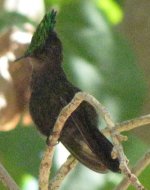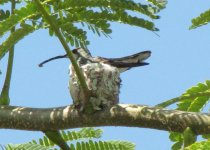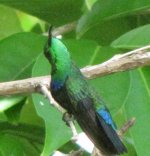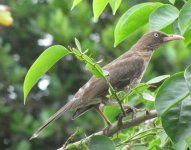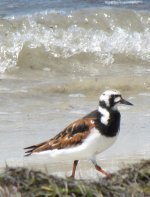Next day we had a leisurely breakfast before setting off from Tony and Bonnie's, and headed for El Yunque, the most well known of PR's protected areas of montane forest.
Although most (maybe all) of the PR montane endemics can be found at El Yunque, it looks from trip reports that they're mostly easier to see around Maricau in the west of the island. I hoped to have my first taste of some of these endemics at El Yunque, but my main target bird for this morning was better views of the more globally widespread
Black Swift.
We cruised up the coast road, stopping to look at some
Brown Pelicans and a lone
Royal Tern, before heading for El Yunque's northern approach. The journey through the lowlands picked up (of note) a smattering of
Cave Swallows in small groups, mostly by low bridges, and the occasional
Caribbean Martin.
We then wound up into the hills, and stopped by an information board just past the main reserve HQ. We were now in the forest, and although it was pretty quiet I'd no sooner stepped out of the car when a movement caught my eye, and I found myself staring at one of PR's special birds. As far as I'm concerned there's nothing not to like about a
PR Tody. Neat dazzling little things, no bigger than Blue Tits, but looking like a cross between a kingfisher and a jacamar. Great to watch as they dart about catching things, but easy to follow and get prolonged close looks at as they stare back at you. Although we only saw one that day, we were to discover that they're one of the commoner PR endemics, adding a bit of glitz to most of our woodland walks during our holiday.
While we were still admiring our tody, another unfamiliar call led us to a pair of
PR Tanagers passing through. A modest critter by tanager standards, but quite unique nonetheless. I hoped this was to be the start of a small bird wave, but all fell silent as the tanagers parted. We got back in the car and pressed on into the park, stopping at Coca Falls lookout, where the 2 endemic PR hummingbirds are sometimes seen. There were very few flowers, a fair few tourists, and no sign of any birds except
Bananaquits, and flyover
White-winged Doves and
Scaly-naped Pigeons.
We pressed on to Yokahu lookout, which is mentioned in the Birdwatcher's Guide as a good spot to see
Black Swift from mid April. I was gutted to discover that the area to park here was closed (temporarily?). We continued up the hill and saw there was a 'window' in the forest on the left side of the road within a short distance, and a place to pull over soon after, also on the left. We stopped, and walked back down the road until we reached the 'window' from where we could scan over an extensive area of forest below. This was not only quite an impressive view, but I'd not been there 5 minutes before 2
Black Swifts appeared in the 'window', providing much closer views than the previous day, viewable both against the sky and the trees. A fair few distant pigeons and a couple of
Red-tailed Hawks were also seen.
We explored further into the park for a couple of hours but saw very little except
Bananaquits,
Pearly-eyed Thrashers and a couple of unidentified hummingbirds chasing each other across the road at the speed of light. A loud clear song eventually led us to great views of another of the commoner PR endemics, a smart male
PR Bullfinch, before we decided it was time to continue with our plan to head for the beach at Cabezas de San Juan, for some swimming and snorkelling. We saw little here birdwise except a few really smart (sorry Peter!

) adult
Laughing Gulls in breeding plumage, and quite a large gang of
Pin-tailed Whydahs. The snorkelling was disappointing here, but the sea nice and warm.
As it got later it was time to go chasing after my other remaining target bird for the east end of the island,
Plain Pigeon. This is where we learned to have a bit more respect for the distances around here! We totally misguaged how long it would take to get to the Plain Pigeon site at Comeria. We only had a very small and basic map from the car hire place, and we ended up going the wrong way on a highway with no options to turn back for ages (and going through a toll!). When we could finally turn round we hit a traffic jam. At Caguas we realised we were too late, so we made sure we plotted a route back to Humacao where the roads flowed in both directions, to ensure that when we returned for another go tomorrow, we could at least get through Caguas to the road to Aguas Buenas (and on to the pigeon site), without getting lost.




